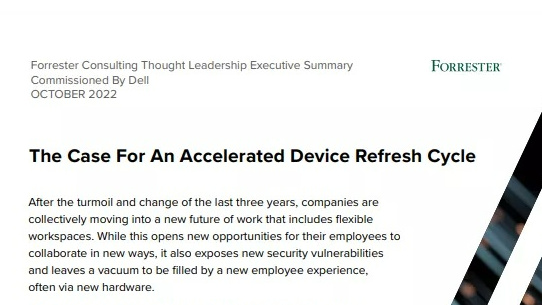How to improve collaboration in your business
Teams can work together from anywhere at any time with the right technology and practices in place

In business, collaboration used to mean one team in one office at one time. Not any more. New working practices are enabling workers to work remotely, whether from home, a shared workspace or while out on the road. In some companies, this is even becoming the norm, with a highly distributed workforce where the teams all work remotely and rarely if ever physically meet.
It's a shift enabled by technology; by mobile technology that gives you the performance of a desktop PC in a package that slips into a backpack and weighs well under 2kg; by ubiquitous broadband, public Wi-Fi networks and high-speed 4G and soon 5G mobile comms. It's a shift supported by VPN links back to company resources, online tools and the glue that holds it all together the cloud. When you have the applications and data you need, accessible from anywhere, at any time on almost any device, your physical location becomes almost irrelevant.
This dovetails neatly with the move to flexible and agile working practices. In 2017, more than half of UK organisations were likely to have adopted flexible working policies, according to a report from the Work Foundation at Lancaster University, with more than 70% due to adopt them by 2020.
By allowing employees to work in the office or the home, in the location and, in some cases, the times when they can be most productive, businesses have found tangible benefits in terms of employee happiness, retention and output. Agile working practices stretch the concept even further, tying flexible working to new ways of doing business, where it's less about where and when you work than about what you deliver. Agile working can help companies take their business to the customer, make it more responsive and build a culture of innovation.
But what does this mean for teamwork? On the one hand, these new working practices are great for teamwork, breaking down geographical and departmental divisions, so that teams pull together to meet certain goals, irrespective of where they're based. It doesn't matter where we are or who we report to we're all in this together. Yet isolation can be a challenge, as can tracking tasks, working together on stages of a project or sharing ideas and feedback with the team. At times, it's hard to feel like you're working in a team when you're sitting alone at your desk, with nobody at hand to look over what you're doing or bounce ideas.

Meeting these challenges involves a cocktail of technologies and services. Cloud-based project management tools like Asana or Trello make it easier for teams to track progress in a project and assign and schedule tasks. Messaging platforms like Cisco Webex Teams can help workers in a team to communicate and share ideas in a more open, immediate and responsive way than email, with search facilities that help you find a reference or discussion without having to plough through a mass of email threads.
Meanwhile, productivity platforms like Office 365 and Google Docs enable several remote workers to edit, review and comment on the same document at the same time. Cloud-based storage and Business Intelligence dashboards put the information you need to make decisions at your fingertips, wherever you might be.
With these basic tools at your disposal, you can battle isolation, so that employees never feel disconnected from their colleagues, whether they're working in the office or not. What's more, they have the tools to collaborate effectively, so that they can share a document or web page with the same ease with which they might pass over the same document on paper or ask the colleague to pop over and look at what they've got on-screen.
That's great, but real collaboration means taking things up another level, making working with remote colleagues as natural and intuitive as working under the same roof. Unified communications applications, such as Cisco Jabber, pull together instant messaging, voice and video calls, desktop sharing and audio and/or video conferencing. This gives you the speed and immediacy of instant messaging, with a more casual, friendly experience that brings back some of the chatting in the office feel. And when you need more, you can break out into a voice or video call, almost instantly, to talk things through. From there you have the option to expand into a conference with full desktop sharing to show exactly what you're working on. Remote workers can join in from their laptop, phone or tablet, making these tools perfect for flexible working.
Regular virtual meetings are another great idea, bringing workers together to talk through progress, troubleshoot problems and sometimes just remind everyone that they're not on their own. Here services like Cisco Webex Teams simplify online voice and video meetings involving workers in the office, remote workers plus partners and outside consultants.
Businesses can also give their workers not just the means to collaborate but a productive virtual space in which to do it. Cisco Webex Teams, for instance, gives teams a secure space in which they can share files and online whiteboards and send messages, again with integrated voice and video meetings or multi-person calls. The advantage is that there's no need to switch from one platform or tool to another when it's time to get around the virtual table; all the necessary functions are already integrated, and these services are designed to work seamlessly with Microsoft Office and other popular productivity tools.
These collaboration tools work in the cloud, using the devices workers already have to hand. Yet businesses can make the office more open to collaboration by deploying some technology in-house. Cisco Webex room kits can fit a meeting room out with all the cameras, displays, speakers and microphones needed to link workers operating inside and outside the office in a seamless, high-tech meeting experience using just a couple of easy to install and stylish units.
The technology is there to empower real collaboration, no matter where or when individual members of a team are working, and no matter what device they're working through. And it's not just making workers happier and more productive, but enabling companies to grow more agile, too.
Sign up today and you will receive a free copy of our Future Focus 2025 report - the leading guidance on AI, cybersecurity and other IT challenges as per 700+ senior executives
Stuart has been writing about technology for over 25 years, focusing on PC hardware, enterprise technology, education tech, cloud services and video games. Along the way he’s worked extensively with Windows, MacOS, Linux, Android and Chrome OS devices, and tested everything from laptops to laser printers, graphics cards to gaming headsets.
He’s then written about all this stuff – and more – for outlets, including PC Pro, IT Pro, Expert Reviews and The Sunday Times. He’s also written and edited books on Windows, video games and Scratch programming for younger coders. When he’s not fiddling with tech or playing games, you’ll find him working in the garden, walking, reading or watching films.
You can follow Stuart on Twitter at @SATAndrews.
-
 I couldn’t escape the iPhone 17 Pro this year – and it’s about time we redefined business phones
I couldn’t escape the iPhone 17 Pro this year – and it’s about time we redefined business phonesOpinion ITPro is back on smartphone reviews, as they grow more and more intertwined with our work-life balance
-
 When everything connects, everything’s at risk
When everything connects, everything’s at riskIndustry Insights Growing IoT complexity demands dynamic, automated security for visibility, compliance, and resilience
-
 'Digital hide-and-seek': Workers are wasting hundreds of hours a year sourcing the information they need to carry out their role
'Digital hide-and-seek': Workers are wasting hundreds of hours a year sourcing the information they need to carry out their roleNews Knowledge workers globally are wasting a quarter of their working week tracking down information, new research from Atlassian has revealed.
-
 Untethered: How CIOs and CISOs are paving the way for the new hybrid workforce
Untethered: How CIOs and CISOs are paving the way for the new hybrid workforceWhitepaper Effective techniques to transition from exposed legacy infrastructure to an effective zero trust strategy
-
 Unlocking the power of your digital services
Unlocking the power of your digital servicesSponsored Businesses have invested significant cash into technology since COVID-19, but are they really getting their money's worth?
-
 Delivering fast and secure digital experiences for the modern hybrid workforce
Delivering fast and secure digital experiences for the modern hybrid workforceWhitepaper A new approach to digital experience monitoring that can monitor the health of all systems
-
 Collaboration is the glue that holds your business together
Collaboration is the glue that holds your business togetherSPONSORED A combination of productivity tools and cloud telephony can enable the best from your workforce
-
 The future of work and the forgotten workforce
The future of work and the forgotten workforcewhitepaper How to deploy a mobile-first strategy so no one gets left behind
-
 The case for an accelerated device refresh cycle
The case for an accelerated device refresh cycleWhitepaper Achieving a more cost-effective device lifecycle overall
-
 Employees are choosing how they work
Employees are choosing how they workWhitepaper And with the right secure digital strategy, this could be a great thing for your business: today and far into the future

